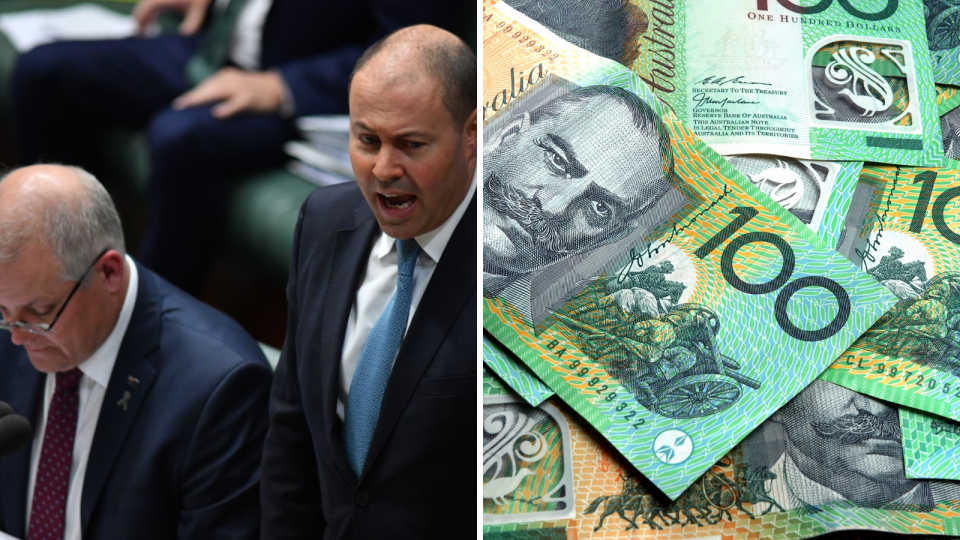'Disconcerting': Australia’s $1 trillion debt explosion exposed

Last week’s Budget lit the fuse on an economic time bomb.
The Morrison Government has locked in a decade or more of massive budget deficits and a never-ending rise in government debt, even though it assumes that a vaccination for Covid-19 will be found next year and the economy will rebound solidly within the next few months.
No one in their right mind would argue against the need for substantial fiscal stimulus measures to tackle the economic fallout from the Covid-19 recession. Indeed, the Morrison Government could and should have done more to help the economy here and now to help those impacted from the recession, even if that meant the budget deficit this year and next were higher than estimated in the budget.
The problem is that the Budget documents show that there is nothing to get the Budget back in the black and back on track after the Covid-19 health crisis has passed.
More from the Kouk: Plenty of temporary Government spending but where are the jobs?
More from the Kouk: The Reserve Bank is missing its target – again
Nothing. Not one policy reform or initiative.
Indeed, a number of the decisions to tackle the 18 to 24 month recession unleashed by Covid-19, have been baked into huge deficits forever.
The income tax cuts, for example, will still be coming out of the Budget bottom line after the recession has ended and Australia and the world has learnt to live with Covid-19.
While payments including the JobKeeper scheme and the increase in JobSeeker payments are temporary and are set to be phased out in coming months, there is not a single policy in the budget that is designed to see a pick up in revenue or trim expenditure when the Covid-19 crisis is over.
In areas such as defence, for example, spending is running rampant with increases in real terms of 8 per cent per annum for the next few years.
The numbers
Even in 2023-24, when the economy has registered several years of growth and the unemployment rate is on a clear trend lower, the budget deficit will still be $67 billion. And this massive deficit will be hit without one cent of JobKeeper payments or any of the other temporary measures.
Gross government debt is forecast to hit $1.138 trillion in June 2024. Net government debt will be $966 billion.
The disconcerting issue is that Treasurer Frydenberg is aiming for 17 years of budget deficits. Indeed, even in 2030-31, Mr Frydenberg is estimating the budget to be 1.6 per cent of GDP which will be around $50 billion. Only in 2028-29 will the budget deficit be under 2 per cent of GDP.
And these forecasts and projections assume the economy does not suffer any economic setbacks over the next decade. If there is a dip, for any reason, these budget deficits and the level of debt will be even higher.
Buried away in the budget paper is the estimate that by 2031, gross government debt will be around $1.7 trillion with net debt around $1.175 trillion.
Why it matters
It is well established, basic economics that budget deficits are prudent when the economy is weak, and budget surpluses are good policy when the economy is strong.
This simple rule of thumb has served Australia well for around four decades, but has been jettisoned from economic planning in the latest Frydenberg budget.
For the moment, while interest rates are very low, the cost of servicing the new debt is also low. This is good news.
But how long will these low interest rates last?
It would be a mistake to assume that over the next five years, let alone the next decade, interest rates will remain as low as they are today. Indeed, if the budget forecasts for the economy turn out to be correct, interest rates are likely to move higher, by perhaps 3 or 4 percentage points over the medium term. This would feed into a substantial rise in the Government’s allocation of funds to pay that interest.
Indeed, if there still are budget deficits in the second half of the 2020s, interest rates are higher than today and there are many tens of billions of dollars of government bonds to refinance, the government will be allocating 4 or perhaps 5 per cent of its total spending to pay the interest costs on its debt.
This would be a poor use of scarce finances.
This is why, when the economy finds its feet and the labour market is back to full employment, some genuine budget repair will be needed.
It is no surprise that Covid-19 has smashed the Government’s finances. The big question, which has squibbed in the budget, is how to repair the damage.
Make your money work with Yahoo Finance’s daily newsletter. Sign up here and stay on top of the latest money, news and tech news.
Follow Yahoo Finance Australia on Facebook, Twitter, Instagram and LinkedIn.

 Yahoo Finance
Yahoo Finance 